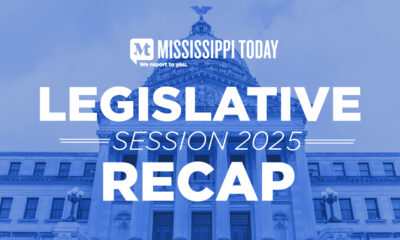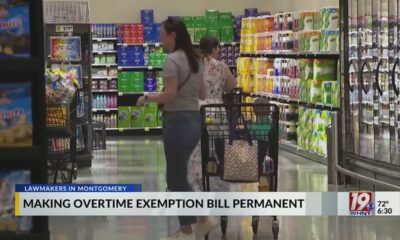Kaiser Health News
Social Security Overpays Billions to People, Many on Disability. Then It Asks for the Money Back.
David Hilzenrath and Jodie Fleischer, Cox Media Group
Fri, 15 Sep 2023 09:00:00 +0000
Justina Worrell, 47, works part time as a kitchen helper in an Ohio nursing home. She has cerebral palsy, an intellectual disability, and a cardiac condition that required she get an artificial heart valve at age 20.
A year ago, she was earning $862 a month and receiving about $1,065 in monthly Social Security disability benefits when a letter arrived from the federal government. The Social Security Administration had been overpaying her, the letter said, and wanted money back.
Within 30 days, it said, she should mail the government a check or money order.
For $60,175.90.
“Social Security should be to help people, not to destroy them,” said Addie Arnold, Worrell’s aunt and caregiver.
The Social Security Administration is trying to reclaim billions of dollars from many of the nation’s poorest and most vulnerable — payments it sent them but now says they never should have received.
During the 2022 fiscal year, the agency clawed back $4.7 billion of overpayments, while another $21.6 billion remained outstanding, according to a report by SSA’s inspector general.
One consequence is a costly collection effort for the government and a potentially devastating ordeal for the beneficiary.
“We have an overpayment crisis on our hands,” said Rebecca Vallas, a senior fellow at the Century Foundation think tank.
“Overpayments push already struggling beneficiaries even deeper into poverty and hardship, which is directly counterproductive to the goals” of safety-net programs.
The Social Security Administration declined an interview request from KFF Health News and Cox Media Group and would field questions only submitted by email.
The agency declined to say how many people have been asked to repay overpayments.
“We do not report on the number of debtors,” spokesperson Nicole Tiggemann said in a statement.
The agency rejected a May 2022 Freedom of Information Act request for documentation of every overpayment notice sent over several years, and a March 2023 appeal is pending.
Jack Smalligan of the Urban Institute, who has done research on Social Security, estimated that millions of people have received notices saying the agency overpaid them.
Most are on disability, and many cannot afford to repay the government, Smalligan said.
Overpayments can result from Social Security making a mistake or from beneficiaries failing to comply with requirements, intentionally or otherwise. But much of the fault lies within the system — for example:
- Rules are complex and hard to follow.
- Limits on what beneficiaries can save or own have not been adjusted for inflation in decades.
- The Social Security Administration does not have adequate staffing to keep up with its workload, much of which is done by hand.
- The system has built-in lags in checking information such as beneficiaries’ income and relies heavily on data submitted by beneficiaries themselves.
That’s the picture that emerges from agency employees, advocates for the disabled, policy research, SSA publications, reports by the inspector general, records of individual cases, and interviews with more than a dozen people in five states who received repayment notices.
The Social Security Administration is required to be a good steward of the money entrusted to it. That means keeping overpayments to a minimum — and recovering them when they happen, the inspector general has written.
When the agency determines it has overpaid, SSA can ultimately reclaim money from beneficiaries by, for instance, reducing or stopping their monthly benefit payments, garnishing wages, and intercepting federal tax refunds.
The agency tracks its overpayments through quarterly “payment integrity scorecards.” In the most recent scorecard for one Social Security program, the agency said $265 million of overpayments in the 2022 fiscal year were “within the agency’s control.” In other words, the agency blamed itself.
“We were aware of information but failed to take action, or we took incorrect action when the recipient or third-party provided requested information,” the scorecard said.
A much larger source of overpayments in that program, the agency said, was that beneficiaries did not report information, such as changes in their wages or assets.
By the time the agency catches a mistake, years can pass. In the meantime, the beneficiary is likely to have spent the money, and the amount involved can grow to overwhelming proportions.
“We understand getting notice of an overpayment may be unsettling or unclear and we work with people to navigate the overpayment process,” Tiggemann, the agency spokesperson, said by email.
The agency’s payment accuracy is high, Tiggemann said, but given the volume of payments it issues — almost $1.2 trillion in the 2021 fiscal year — “even small error rates add up to substantial improper payment amounts.”
Tiggemann noted that the SSA is developing a program to tap payroll data from outside sources. The agency plans to use that information “when appropriate” to automatically adjust the amounts it pays beneficiaries, she said.
Congress authorized that project almost eight years ago.
Tangled Safety Nets
When people hear “Social Security,” they may think of retirement benefits — the monthly payments the government issues to millions of retired workers and surviving family members under the Old-Age and Survivors Insurance program.
But the Social Security Administration does much more than issue those checks, and its clawbacks for overpayment commonly involve payments under other programs with complicated eligibility requirements.
With certain benefits, how much money — if any — beneficiaries are due each month can change as their circumstances change.
Most of the overpayments involve the Supplemental Security Income program, which provides money to people with little or no income or other resources who are disabled, blind, or at least 65.
In the 2021 fiscal year, more than 7% of that program’s outlays were overpayments, according to the agency’s most recent annual financial report.
Some overpayments involve the Disability Insurance program, which assists disabled workers and their dependents.
Lori Cochran, a beneficiary disabled by multiple sclerosis, said she got tripped up by a life insurance policy she took over from her mother.
After she reviewed her finances with a Social Security representative, she recounted, she received a letter saying she owed $27,000.
“I started having, like, heart palpitations,” she recalled.
Cochran said she didn’t know the insurance policy had a cash value of $4,000.
The agency told her that, for every month she held the policy, she wasn’t entitled to any of her $914 monthly benefit, she said. The agency said it would recoup the $27,000 by deducting $91.40 from each of her future checks. At that rate, she would be paying it back “way into my elderly age,” she said.
Cochran has asked SSA to reconsider. In the meantime, she cashed out the life insurance policy — only to learn that, instead, she could have signed a paper saying she had no intention of cashing it out.
“So now I’m left with no life insurance,” she said. “When I die, my daughter will have no money to bury me.”
A ‘Kafkaesque Minefield’
If beneficiaries believe that an overpayment wasn’t their fault, that the claim is unfair, or that paying the money back would cause hardship, they can ask the SSA to waive repayment.
They can also negotiate to repay what they owe gradually.
Cheryl Bates-Harris of the National Disability Rights Network recommended that people who receive overpayment notices appeal, because the information in the notices may be inaccurate.
But trying to resolve an overpayment involves plunging into a “Kafkaesque minefield,” said Darcy Milburn, director of Social Security and health care policy at the Arc, which advocates for people with disabilities.
Another beneficiary named Lori described her journey through the minefield on the condition that her last name be withheld. She provided a copy of an administrative law judge’s ruling in her case.
In 2017, SSA informed her that, since 2000, she had been overpaid $126,612, according to the judge’s ruling.
“I almost threw up when I opened that letter,” she said. “Myself and my husband were like, we were like frantic.”
According to the judge’s ruling, the government based its calculation on her receipt of workers’ compensation benefits as well as disability benefits. She argued that she had told the SSA about the workers’ comp. Lori worked for the U.S. Postal Service until she injured her back.
As her struggle unfolded, the government reduced her monthly benefit checks and then stopped them. She and her husband sold their car and their house and moved from Florida to Georgia, where the cost of living was lower.
She said she ran up credit card debt and called lawyer after lawyer but was told no attorney would help because there was no money to be made from a Social Security case. Then she found one through legal aid.
After six years of battling SSA, including multiple appeals, Lori prevailed. An administrative judge ruled in her favor and wiped away the debt.
Lori had spent her benefit money in the belief she was entitled to it, the judge wrote, and “requiring repayment would be against equity and good conscience.”
A family in Covington, Georgia, had a similar experience.
In 2018, Matt Cooper was shot in the face while working as a police officer there. Since then, he and his wife, Kristen, have depended on Social Security payments to help support their two young children.
“Every decision that we made for our family was based on the benefits that we were supposed to receive,” Kristen Cooper said.
But the Social Security Administration recently demanded the family pay back $30,000 and reduced the children’s benefits. Cooper said the agency failed to correctly include her husband’s workers’ compensation in its calculations.
“Situations like this come up and it just brings back a level of anger and just the need to protect my family,” she said. “The system has definitely let us down.”
Too Late
Alex Hubbard, 30, has autism and said he works in a mailroom to keep busy.
“I like to be busy because I don’t want to be bored at home,” he said.
In 2019, Hubbard received an overpayment notice for $11,111.43.
“I’m supposed to report my wages, but I just don’t know how, how it works,” said the Seattle resident.
The agency has cut off his benefits, Hubbard said, but it would have been better if it had stopped them before he owed all that money.
“They should have let me know, like, years back that I owed back that much,” Hubbard said.
Now, the agency is trying to collect the money from his mother, who is unable to manage his benefits since having a stroke, Hubbard said.
Dealing with the Social Security Administration can be exasperating, beneficiaries said.
Letters from the agency don’t provide clear explanations, and, if people on the receiving end of overpayment notices can get through to a human, agency employees give inconsistent answers, beneficiaries said.
SSA employees interviewed for this article, speaking as union leaders, said they can relate.
Beneficiaries “struggle getting through to an agency that has all but become non-responsive to the public at this point due to understaffing,” said Jessica LaPointe, a claims specialist in SSA’s Madison, Wisconsin, field office and president of a union council representing Social Security employees.
Tiggemann, the agency spokesperson, cited the challenge of “staffing losses and resource constraints” in her written statement.
In a March 2023 budget message, SSA’s acting commissioner, Kilolo Kijakazi, said SSA was “rebuilding” its workforce after ending the 2022 fiscal year “at our lowest staffing level in over 25 years.”
New workers need a long time to get up to speed, employees said. Complex rules cause trouble for employees and beneficiaries alike.
Members of the public “often struggle to really understand what they’re supposed to report,” LaPointe said.
Rules for the Beneficiaries
Disability benefits are meant for people who can’t do a lot of work.
For disabled people who aren’t blind, the government generally draws a line at earning $1,470 or more per month.
It’s not just bank balances or paycheck amounts and the like that can affect a person’s benefits. In the SSI program, if a family member gives them meals or a place to stay, that can count as “in-kind support.”
Part of the trouble with SSI, critics say, is that limits on the assets that beneficiaries are allowed to hold without forfeiting benefits haven’t been adjusted since 1989. The asset limits stand at $2,000 for individuals and $3,000 for couples.
Had the asset limits been indexed for inflation since 1972, when the program was created, they would be almost five times as much as they are today, according to a July 2023 report by researchers at the Center on Budget and Policy Priorities.
Maintaining eligibility for SSI benefits leaves people with little money to fall back on — let alone to repay a large debt to the government.
A bipartisan group of lawmakers introduced a bill on Sept. 12 to raise the limits.
The SSDI and SSI programs include rules meant to encourage people to work. However, “if beneficiaries attempt work, they are likely to be confronted with an overpayment, and it is likely to be large,” Smalligan and Chantel Boyens of the Urban Institute said in a March 2023 report commissioned by the Social Security Advisory Board.
‘In a Very Bad Place’
Justina Worrell’s aunt and caregiver Addie Arnold, 69, who took her in when she was orphaned as a child, said neither of them has $60,175.90 to repay the government.
The August 2022 letter demanding repayment of that amount was not the first or the last word they have received from the Social Security Administration about possible payment errors. The matter involves two streams of benefits — one from the account of Worrell’s deceased father, and another related to her disability, Arnold said.
“I’ve been confused ever since this started,” she said.
A February 2023 letter from the SSA claiming to explain how “we paid her [Worrell] $7,723.40 too much in benefits” includes difficult-to-decipher data going back to 1996.
The SSA has dropped its claim on some of the more than $60,000 it sought a year ago, but most remains outstanding, Arnold said.
Arnold believes part of the problem is that Worrell’s employer asked her to work additional hours at the nursing home, where she runs a dishwasher and carries trays.
“She is so afraid of losing her job that she will do whatever they ask her to do. That is part of her mental state,” Arnold wrote in a letter appealing to the Social Security Administration.
“I truly do hope and pray that she is allowed to stay on SSI,” Arnold wrote, “because she has to continue to live and without it she will be in a very bad place.”
Reporters contributing to this investigation: Josh Wade, Cox Media Group; Justin Gray, WSB-TV, Atlanta; John Bedell, WHIO-TV, Dayton, Ohio; Shannon Butler, WFTV-TV, Orlando, Florida; Amy Hudak, WPXI-TV, Pittsburgh; Jesse Jones, KIRO-TV, Seattle; Ted Daniel, WFXT-TV, Boston; Madison Carter, WSOC-TV, Charlotte, North Carolina; Ben Becker, WJAX-TV, Jacksonville, Florida
——————————
By: David Hilzenrath and Jodie Fleischer, Cox Media Group
Title: Social Security Overpays Billions to People, Many on Disability. Then It Asks for the Money Back.
Sourced From: kffhealthnews.org/news/article/social-security-overpayments-investigation/
Published Date: Fri, 15 Sep 2023 09:00:00 +0000
Did you miss our previous article…
https://www.biloxinewsevents.com/a-new-covid-booster-is-here-will-those-at-greatest-risk-get-it/
Kaiser Health News
US Judge Names Receiver To Take Over California Prisons’ Mental Health Program
SACRAMENTO, Calif. — A judge has initiated a federal court takeover of California’s troubled prison mental health system by naming the former head of the Federal Bureau of Prisons to serve as receiver, giving her four months to craft a plan to provide adequate care for tens of thousands of prisoners with serious mental illness.
Senior U.S. District Judge Kimberly Mueller issued her order March 19, identifying Colette Peters as the nominated receiver. Peters, who was Oregon’s first female corrections director and known as a reformer, ran the scandal-plagued federal prison system for 30 months until President Donald Trump took office in January. During her tenure, she closed a women’s prison in Dublin, east of Oakland, that had become known as the “rape club.”
Michael Bien, who represents prisoners with mental illness in the long-running prison lawsuit, said Peters is a good choice. Bien said Peters’ time in Oregon and Washington, D.C., showed that she “kind of buys into the fact that there are things we can do better in the American system.”
“We took strong objection to many things that happened under her tenure at the BOP, but I do think that this is a different job and she’s capable of doing it,” said Bien, whose firm also represents women who were housed at the shuttered federal women’s prison.
California corrections officials called Peters “highly qualified” in a statement, while Gov. Gavin Newsom’s office did not immediately comment. Mueller gave the parties until March 28 to show cause why Peters should not be appointed.
Peters is not talking to the media at this time, Bien said. The judge said Peters is to be paid $400,000 a year, prorated for the four-month period.
About 34,000 people incarcerated in California prisons have been diagnosed with serious mental illnesses, representing more than a third of California’s prison population, who face harm because of the state’s noncompliance, Mueller said.
Appointing a receiver is a rare step taken when federal judges feel they have exhausted other options. A receiver took control of Alabama’s correctional system in 1976, and they have otherwise been used to govern prisons and jails only about a dozen times, mostly to combat poor conditions caused by overcrowding. Attorneys representing inmates in Arizona have asked a judge to take over prison health care there.
Mueller’s appointment of a receiver comes nearly 20 years after a different federal judge seized control of California’s prison medical system and installed a receiver, currently J. Clark Kelso, with broad powers to hire, fire, and spend the state’s money.
California officials initially said in August that they would not oppose a receivership for the mental health program provided that the receiver was also Kelso, saying then that federal control “has successfully transformed medical care” in California prisons. But Kelso withdrew from consideration in September, as did two subsequent candidates. Kelso said he could not act “zealously and with fidelity as receiver in both cases.”
Both cases have been running for so long that they are now overseen by a second generation of judges. The original federal judges, in a legal battle that reached the U.S. Supreme Court, more than a decade ago forced California to significantly reduce prison crowding in a bid to improve medical and mental health care for incarcerated people.
State officials in court filings defended their improvements over the decades. Prisoners’ attorneys countered that treatment remains poor, as evidenced in part by the system’s record-high suicide rate, topping 31 suicides per 100,000 prisoners, nearly double that in federal prisons.
“More than a quarter of the 30 class-members who died by suicide in 2023 received inadequate care because of understaffing,” prisoners’ attorneys wrote in January, citing the prison system’s own analysis. One prisoner did not receive mental health appointments for seven months “before he hanged himself with a bedsheet.”
They argued that the November passage of a ballot measure increasing criminal penalties for some drug and theft crimes is likely to increase the prison population and worsen staffing shortages.
California officials argued in January that Mueller isn’t legally justified in appointing a receiver because “progress has been slow at times but it has not stalled.”
Mueller has countered that she had no choice but to appoint an outside professional to run the prisons’ mental health program, given officials’ intransigence even after she held top officials in contempt of court and levied fines topping $110 million in June. Those extreme actions, she said, only triggered more delays.
The 9th U.S. Circuit Court of Appeals on March 19 upheld Mueller’s contempt ruling but said she didn’t sufficiently justify calculating the fines by doubling the state’s monthly salary savings from understaffing prisons. It upheld the fines to the extent that they reflect the state’s actual salary savings but sent the case back to Mueller to justify any higher penalty.
Mueller had been set to begin additional civil contempt proceedings against state officials for their failure to meet two other court requirements: adequately staffing the prison system’s psychiatric inpatient program and improving suicide prevention measures. Those could bring additional fines topping tens of millions of dollars.
But she said her initial contempt order has not had the intended effect of compelling compliance. Mueller wrote as far back as July that additional contempt rulings would also be likely to be ineffective as state officials continued to appeal and seek delays, leading “to even more unending litigation, litigation, litigation.”
She went on to foreshadow her latest order naming a receiver in a preliminary order: “There is one step the court has taken great pains to avoid. But at this point,” Mueller wrote, “the court concludes the only way to achieve full compliance in this action is for the court to appoint its own receiver.”
This article was produced by KFF Health News, which publishes California Healthline, an editorially independent service of the California Health Care Foundation.
If you or someone you know may be experiencing a mental health crisis, contact the 988 Suicide & Crisis Lifeline by dialing or texting “988.”
The post US Judge Names Receiver To Take Over California Prisons’ Mental Health Program appeared first on kffhealthnews.org
Kaiser Health News
Amid Plummeting Diversity at Medical Schools, a Warning of DEI Crackdown’s ‘Chilling Effect’
The Trump administration’s crackdown on DEI programs could exacerbate an unexpectedly steep drop in diversity among medical school students, even in states like California, where public universities have been navigating bans on affirmative action for decades. Education and health experts warn that, ultimately, this could harm patient care.
Since taking office, President Donald Trump has issued a handful of executive orders aimed at terminating all diversity, equity, and inclusion, or DEI, initiatives in federally funded programs. And in his March 4 address to Congress, he described the Supreme Court’s 2023 decision banning the consideration of race in college and university admissions as “brave and very powerful.”
Last month, the Education Department’s Office for Civil Rights — which lost about 50% of its staff in mid-March — directed schools, including postsecondary institutions, to end race-based programs or risk losing federal funding. The “Dear Colleague” letter cited the Supreme Court’s decision.
Paulette Granberry Russell, president and CEO of the National Association of Diversity Officers in Higher Education, said that “every utterance of ‘diversity’ is now being viewed as a violation or considered unlawful or illegal.” Her organization filed a lawsuit challenging Trump’s anti-DEI executive orders.
While California and eight other states — Arizona, Florida, Idaho, Michigan, Nebraska, New Hampshire, Oklahoma, and Washington — had already implemented bans of varying degrees on race-based admissions policies well before the Supreme Court decision, schools bolstered diversity in their ranks with equity initiatives such as targeted scholarships, trainings, and recruitment programs.
But the court’s decision and the subsequent state-level backlash — 29 states have since introduced bills to curb diversity initiatives, according to data published by the Chronicle of Higher Education — have tamped down these efforts and led to the recent declines in diversity numbers, education experts said.
After the Supreme Court’s ruling, the numbers of Black and Hispanic medical school enrollees fell by double-digit percentages in the 2024-25 school year compared with the previous year, according to the Association of American Medical Colleges. Black enrollees declined 11.6%, while the number of new students of Hispanic origin fell 10.8%. The decline in enrollment of American Indian or Alaska Native students was even more dramatic, at 22.1%. New Native Hawaiian or other Pacific Islander enrollment declined 4.3%.
“We knew this would happen,” said Norma Poll-Hunter, AAMC’s senior director of workforce diversity. “But it was double digits — much larger than what we anticipated.”
The fear among educators is the numbers will decline even more under the new administration.
At the end of February, the Education Department launched an online portal encouraging people to “report illegal discriminatory practices at institutions of learning,” stating that students should have “learning free of divisive ideologies and indoctrination.” The agency later issued a “Frequently Asked Questions” document about its new policies, clarifying that it was acceptable to observe events like Black History Month but warning schools that they “must consider whether any school programming discourages members of all races from attending.”
“It definitely has a chilling effect,” Poll-Hunter said. “There is a lot of fear that could cause institutions to limit their efforts.”
Numerous requests for comment from medical schools about the impact of the anti-DEI actions went unreturned. University presidents are staying mum on the issue to protect their institutions, according to reporting from The New York Times.
Utibe Essien, a physician and UCLA assistant professor, said he has heard from some students who fear they won’t be considered for admission under the new policies. Essien, who co-authored a study on the effect of affirmative action bans on medical schools, also said students are worried medical schools will not be as supportive toward students of color as in the past.
“Both of these fears have the risk of limiting the options of schools folks apply to and potentially those who consider medicine as an option at all,” Essien said, adding that the “lawsuits around equity policies and just the climate of anti-diversity have brought institutions to this place where they feel uncomfortable.”
In early February, the Pacific Legal Foundation filed a lawsuit against the University of California-San Francisco’s Benioff Children’s Hospital Oakland over an internship program designed to introduce “underrepresented minority high school students to health professions.”
Attorney Andrew Quinio filed the suit, which argues that its plaintiff, a white teenager, was not accepted to the program after disclosing in an interview that she identified as white.
“From a legal standpoint, the issue that comes about from all this is: How do you choose diversity without running afoul of the Constitution?” Quinio said. “For those who want diversity as a goal, it cannot be a goal that is achieved with discrimination.”
UC Health spokesperson Heather Harper declined to comment on the suit on behalf of the hospital system.
Another lawsuit filed in February accuses the University of California of favoring Black and Latino students over Asian American and white applicants in its undergraduate admissions. Specifically, the complaint states that UC officials pushed campuses to use a “holistic” approach to admissions and “move away from objective criteria towards more subjective assessments of the overall appeal of individual candidates.”
The scrutiny of that approach to admissions could threaten diversity at the UC-Davis School of Medicine, which for years has employed a “race-neutral, holistic admissions model” that reportedly tripled enrollment of Black, Latino, and Native American students.
“How do you define diversity? Does it now include the way we consider how someone’s lived experience may be influenced by how they grew up? The type of school, the income of their family? All of those are diversity,” said Granberry Russell, of the National Association of Diversity Officers in Higher Education. “What might they view as an unlawful proxy for diversity equity and inclusion? That’s what we’re confronted with.”
California Attorney General Rob Bonta, a Democrat, recently joined other state attorneys general to issue guidance urging that schools continue their DEI programs despite the federal messaging, saying that legal precedent allows for the activities. California is also among several states suing the administration over its deep cuts to the Education Department.
If the recent decline in diversity among newly enrolled students holds or gets worse, it could have long-term consequences for patient care, academic experts said, pointing toward the vast racial disparities in health outcomes in the U.S., particularly for Black people.
A higher proportion of Black primary care doctors is associated with longer life expectancy and lower mortality rates among Black people, according to a 2023 study published by the JAMA Network.
Physicians of color are also more likely to build their careers in medically underserved communities, studies have shown, which is increasingly important as the AAMC projects a shortage of up to 40,400 primary care doctors by 2036.
“The physician shortage persists, and it’s dire in rural communities,” Poll-Hunter said. “We know that diversity efforts are really about improving access for everyone. More diversity leads to greater access to care — everyone is benefiting from it.”
This article was produced by KFF Health News, which publishes California Healthline, an editorially independent service of the California Health Care Foundation.
The post Amid Plummeting Diversity at Medical Schools, a Warning of DEI Crackdown’s ‘Chilling Effect’ appeared first on kffhealthnews.org
Kaiser Health News
Tribal Health Leaders Say Medicaid Cuts Would Decimate Health Programs
As Congress mulls potentially massive cuts to federal Medicaid funding, health centers that serve Native American communities, such as the Oneida Community Health Center near Green Bay, Wisconsin, are bracing for catastrophe.
That’s because more than 40% of the about 15,000 patients the center serves are enrolled in Medicaid. Cuts to the program would be detrimental to those patients and the facility, said Debra Danforth, the director of the Oneida Comprehensive Health Division and a citizen of the Oneida Nation.
“It would be a tremendous hit,” she said.
The facility provides a range of services to most of the Oneida Nation’s 17,000 people, including ambulatory care, internal medicine, family practice, and obstetrics. The tribe is one of two in Wisconsin that have an “open-door policy,” Danforth said, which means that the facility is open to members of any federally recognized tribe.
But Danforth and many other tribal health officials say Medicaid cuts would cause service reductions at health facilities that serve Native Americans.
Indian Country has a unique relationship to Medicaid, because the program helps tribes cover chronic funding shortfalls from the Indian Health Service, the federal agency responsible for providing health care to Native Americans.
Medicaid has accounted for about two-thirds of third-party revenue for tribal health providers, creating financial stability and helping facilities pay operational costs. More than a million Native Americans enrolled in Medicaid or the closely related Children’s Health Insurance Program also rely on the insurance to pay for care outside of tribal health facilities without going into significant medical debt. Tribal leaders are calling on Congress to exempt tribes from cuts and are preparing to fight to preserve their access.
“Medicaid is one of the ways in which the federal government meets its trust and treaty obligations to provide health care to us,” said Liz Malerba, director of policy and legislative affairs for the United South and Eastern Tribes Sovereignty Protection Fund, a nonprofit policy advocacy organization for 33 tribes spanning from Texas to Maine. Malerba is a citizen of the Mohegan Tribe.
“So we view any disruption or cut to Medicaid as an abrogation of that responsibility,” she said.
Tribes face an arduous task in providing care to a population that experiences severe health disparities, a high incidence of chronic illness, and, at least in western states, a life expectancy of 64 years — the lowest of any demographic group in the U.S. Yet, in recent years, some tribes have expanded access to care for their communities by adding health services and providers, enabled in part by Medicaid reimbursements.
During the last two fiscal years, five urban Indian organizations in Montana saw funding growth of nearly $3 million, said Lisa James, director of development for the Montana Consortium for Urban Indian Health, during a webinar in February organized by the Georgetown University Center for Children and Families and the National Council of Urban Indian Health.
The increased revenue was “instrumental,” James said, allowing clinics in the state to add services that previously had not been available unless referred out for, including behavioral health services. Clinics were also able to expand operating hours and staffing.
Montana’s five urban Indian clinics, in Missoula, Helena, Butte, Great Falls, and Billings, serve 30,000 people, including some who are not Native American or enrolled in a tribe. The clinics provide a wide range of services, including primary care, dental care, disease prevention, health education, and substance use prevention.
James said Medicaid cuts would require Montana’s urban Indian health organizations to cut services and limit their ability to address health disparities.
American Indian and Alaska Native people under age 65 are more likely to be uninsured than white people under 65, but 30% rely on Medicaid compared with 15% of their white counterparts, according to KFF data for 2017 to 2021. More than 40% of American Indian and Alaska Native children are enrolled in Medicaid or CHIP, which provides health insurance to kids whose families are not eligible for Medicaid. KFF is a health information nonprofit that includes KFF Health News.
A Georgetown Center for Children and Families report from January found the share of residents enrolled in Medicaid was higher in counties with a significant Native American presence. The proportion on Medicaid in small-town or rural counties that are mostly within tribal statistical areas, tribal subdivisions, reservations, and other Native-designated lands was 28.7%, compared with 22.7% in other small-town or rural counties. About 50% of children in those Native areas were enrolled in Medicaid.
The federal government has already exempted tribes from some of Trump’s executive orders. In late February, Department of Health and Human Services acting general counsel Sean Keveney clarified that tribal health programs would not be affected by an executive order that diversity, equity, and inclusion government programs be terminated, but that the Indian Health Service is expected to discontinue diversity and inclusion hiring efforts established under an Obama-era rule.
HHS Secretary Robert F. Kennedy Jr. also rescinded the layoffs of more than 900 IHS employees in February just hours after they’d received termination notices. During Kennedy’s Senate confirmation hearings, he said he would appoint a Native American as an assistant HHS secretary. The National Indian Health Board, a Washington, D.C.-based nonprofit that advocates for tribes, in December endorsed elevating the director of the Indian Health Service to assistant secretary of HHS.
Jessica Schubel, a senior health care official in Joe Biden’s White House, said exemptions won’t be enough.
“Just because Native Americans are exempt doesn’t mean that they won’t feel the impact of cuts that are made throughout the rest of the program,” she said.
State leaders are also calling for federal Medicaid spending to be spared because cuts to the program would shift costs onto their budgets. Without sustained federal funding, which can cover more than 70% of costs, state lawmakers face decisions such as whether to change eligibility requirements to slim Medicaid rolls, which could cause some Native Americans to lose their health coverage.
Tribal leaders noted that state governments do not have the same responsibility to them as the federal government, yet they face large variations in how they interact with Medicaid depending on their state programs.
President Donald Trump has made seemingly conflicting statements about Medicaid cuts, saying in an interview on Fox News in February that Medicaid and Medicare wouldn’t be touched. In a social media post the same week, Trump expressed strong support for a House budget resolution that would likely require Medicaid cuts.
The budget proposal, which the House approved in late February, requires lawmakers to cut spending to offset tax breaks. The House Committee on Energy and Commerce, which oversees spending on Medicaid and Medicare, is instructed to slash $880 billion over the next decade. The possibility of cuts to the program that, together with CHIP, provides insurance to 79 million people has drawn opposition from national and state organizations.
The federal government reimburses IHS and tribal health facilities 100% of billed costs for American Indian and Alaska Native patients, shielding state budgets from the costs.
Because Medicaid is already a stopgap fix for Native American health programs, tribal leaders said it won’t be a matter of replacing the money but operating with less.
“When you’re talking about somewhere between 30% to 60% of a facility’s budget is made up by Medicaid dollars, that’s a very difficult hole to try and backfill,” said Winn Davis, congressional relations director for the National Indian Health Board.
Congress isn’t required to consult tribes during the budget process, Davis added. Only after changes are made by the Centers for Medicare & Medicaid Services and state agencies are tribes able to engage with them on implementation.
The amount the federal government spends funding the Native American health system is a much smaller portion of its budget than Medicaid. The IHS projected billing Medicaid about $1.3 billion this fiscal year, which represents less than half of 1% of overall federal spending on Medicaid.
“We are saving more lives,” Malerba said of the additional services Medicaid covers in tribal health care. “It brings us closer to a level of 21st century care that we should all have access to but don’t always.”
This article was published with the support of the Journalism & Women Symposium (JAWS) Health Journalism Fellowship, assisted by grants from The Commonwealth Fund.
KFF Health News is a national newsroom that produces in-depth journalism about health issues and is one of the core operating programs at KFF—an independent source of health policy research, polling, and journalism. Learn more about KFF.
USE OUR CONTENT
This story can be republished for free (details).
The post Tribal Health Leaders Say Medicaid Cuts Would Decimate Health Programs appeared first on kffhealthnews.org
-

 Mississippi Today6 days ago
Mississippi Today6 days agoPharmacy benefit manager reform likely dead
-

 News from the South - Alabama News Feed7 days ago
News from the South - Alabama News Feed7 days ago'I think everybody's concerned': Mercedes-Benz plant eyeing impact of imported vehicle tariffs
-

 News from the South - Florida News Feed6 days ago
News from the South - Florida News Feed6 days agoFlorida special election results: GOP keeps 2 U.S. House seats in Florida
-

 News from the South - South Carolina News Feed4 days ago
News from the South - South Carolina News Feed4 days agoSouth Carolina clinic loses funding due to federal changes to DEI mandates
-

 News from the South - Kentucky News Feed5 days ago
News from the South - Kentucky News Feed5 days ago3 killed in fiery Lexington crash temporarily shuts down portion of New Circle Road
-

 Mississippi Today6 days ago
Mississippi Today6 days agoRole reversal: Horhn celebrates commanding primary while his expected runoff challenger Mayor Lumumba’s party sours
-

 News from the South - Louisiana News Feed6 days ago
News from the South - Louisiana News Feed6 days agoMother turns son's tragedy into mental health mission
-

 News from the South - Alabama News Feed6 days ago
News from the South - Alabama News Feed6 days agoWill Alabama Lawmakers Cut Taxes on Overtime Pay or Groceries? | April 1, 2025 | News 19 at 6 p.m.

















































